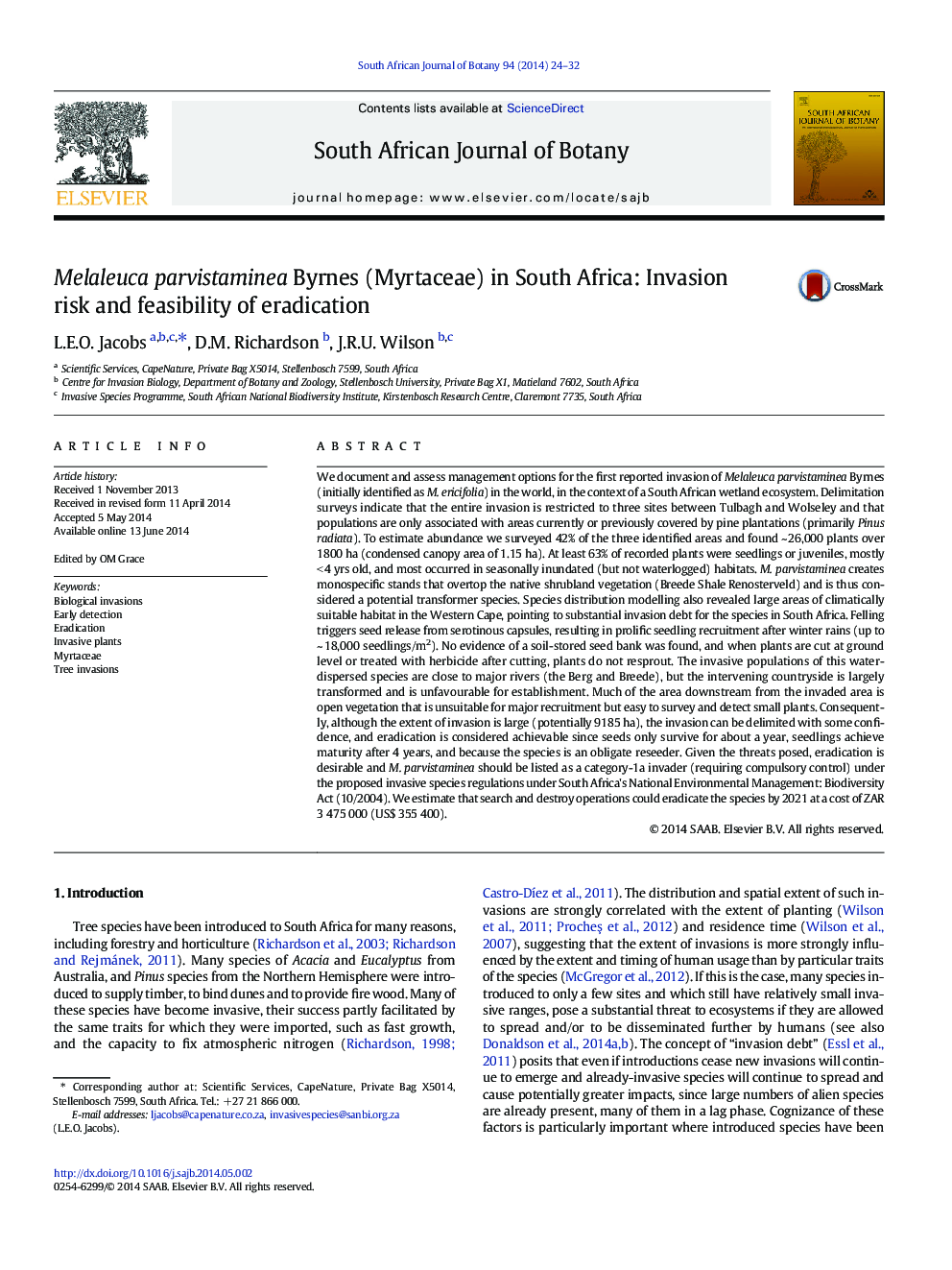| کد مقاله | کد نشریه | سال انتشار | مقاله انگلیسی | نسخه تمام متن |
|---|---|---|---|---|
| 4520659 | 1625164 | 2014 | 9 صفحه PDF | دانلود رایگان |
عنوان انگلیسی مقاله ISI
Melaleuca parvistaminea Byrnes (Myrtaceae) in South Africa: Invasion risk and feasibility of eradication
دانلود مقاله + سفارش ترجمه
دانلود مقاله ISI انگلیسی
رایگان برای ایرانیان
کلمات کلیدی
موضوعات مرتبط
علوم زیستی و بیوفناوری
علوم کشاورزی و بیولوژیک
علوم زراعت و اصلاح نباتات
پیش نمایش صفحه اول مقاله

چکیده انگلیسی
We document and assess management options for the first reported invasion of Melaleuca parvistaminea Byrnes (initially identified as M. ericifolia) in the world, in the context of a South African wetland ecosystem. Delimitation surveys indicate that the entire invasion is restricted to three sites between Tulbagh and Wolseley and that populations are only associated with areas currently or previously covered by pine plantations (primarily Pinus radiata). To estimate abundance we surveyed 42% of the three identified areas and found ~Â 26,000 plants over 1800Â ha (condensed canopy area of 1.15Â ha). At least 63% of recorded plants were seedlings or juveniles, mostly <Â 4Â yrs old, and most occurred in seasonally inundated (but not waterlogged) habitats. M. parvistaminea creates monospecific stands that overtop the native shrubland vegetation (Breede Shale Renosterveld) and is thus considered a potential transformer species. Species distribution modelling also revealed large areas of climatically suitable habitat in the Western Cape, pointing to substantial invasion debt for the species in South Africa. Felling triggers seed release from serotinous capsules, resulting in prolific seedling recruitment after winter rains (up to ~Â 18,000Â seedlings/m2). No evidence of a soil-stored seed bank was found, and when plants are cut at ground level or treated with herbicide after cutting, plants do not resprout. The invasive populations of this water-dispersed species are close to major rivers (the Berg and Breede), but the intervening countryside is largely transformed and is unfavourable for establishment. Much of the area downstream from the invaded area is open vegetation that is unsuitable for major recruitment but easy to survey and detect small plants. Consequently, although the extent of invasion is large (potentially 9185Â ha), the invasion can be delimited with some confidence, and eradication is considered achievable since seeds only survive for about a year, seedlings achieve maturity after 4Â years, and because the species is an obligate reseeder. Given the threats posed, eradication is desirable and M. parvistaminea should be listed as a category-1a invader (requiring compulsory control) under the proposed invasive species regulations under South Africa's National Environmental Management: Biodiversity Act (10/2004). We estimate that search and destroy operations could eradicate the species by 2021 at a cost of ZAR 3 475 000 (US$ 355 400).
ناشر
Database: Elsevier - ScienceDirect (ساینس دایرکت)
Journal: South African Journal of Botany - Volume 94, September 2014, Pages 24-32
Journal: South African Journal of Botany - Volume 94, September 2014, Pages 24-32
نویسندگان
L.E.O. Jacobs, D.M. Richardson, J.R.U. Wilson,